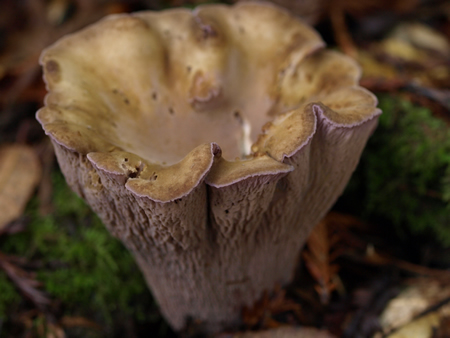recipe of the month
Gomphus clavatus, the Pig's Ear
Gomphus clavatus can be found in the late fall/early winter under Douglas fir trees. The key to eating this mushroom is finding a fresh young specimen that is firm and free of larvae. Young pig's ears have a beautiful lilac purple cast on the exterior surface with shallow forking veins or wrinkles (which resemble the gill ridges of a chanterelle). As the mushroom ages, it fades to a dull tan.
Note: One local store was recently marketing pig's ears as "purple chanterelles," with no warning of the potential for mild gastic upset. As with all mushrooms new to your table, try just a small portion the first time.
Presented below is a tongue-in-cheek medley of several people's experiences with cooking this so-so mushroom.

Young Gomphus clavatus.© Photo by Debbie Viess
Gomphus clavatus stir fry
Sauté sliced pig's ears, garlic, onion, ginger, sweet peppers, tofu, and a cooking sauce made of tamari, Chinese black vinegar and sake. Toss in some garlic chives at the end and serve over jasmine rice. That was pretty good. I made another dish with bacon which was also pretty good, but I credit that more to the bacon than the pig's ears.
Contributed by Heath Curdts
Artichoke hearts and Gomphus clavatus
Sauté equal amounts of raw diced artichoke hearts with gomphus. Add garlic of course, and a pinch of tarragon, salt and pepper or chipotle powder in place of the pepper in 3 parts olive oil, 1 part butter. I usually start the artichokes first and add the rest 3-5 minutes later.
Contributed by John-Marc Ventimiglia
A Recipe for Pig's Ears (Gomphus clavatus)
Rinse the pig's ears thoroughly. Pat dry and slice very thin. In a lightly oiled saute pan place a piece of ginger to flavor oil and cook over high heat to release the flavor. Place the thinly sliced pig's ears into the pan and toss over high heat until lightly browned and caramelized (about 5 minutes). At this point add a clove or two of garlic to taste. Don't put the garlic in earlier as it will burn and provide an unpleasant bitter taste and aroma. Just let the garlic release its flavor and slightly brown and then immediately add a couple tablespoons of chicken stock and cover. Let stand to steam for 1 minute. The stock will have evaporated by this time. Place the pigs ears on paper towels to drain any excess oil and cover tightly with another layer of paper towel. Fold the edges of the paper towel inward to form a tight package of pigs ears. While still very hot transfer the package to the garbage can. This is the best treatment I know for pigs ears.
Contributed (posthumously) by David Bartolotta
Special Cooking Tips
"D'em expert funjeyeicologists, what do dey know 'bout cookin'?"
Dry sauteed some chopped up, mostly maggot-free Gomphus clavatus.
Deeply inhaled rising steam from pan. Hmmm, smells... familiar.
Stuck nose in armpit. (Still haven't showered from yesterday's foray).
Smelled sauteed pig's ears again.
Came up with algebraic equation:
2 Pig's Ears = 0.24 Sweaty Mushroomer Armpit
[Still in denial, she puts a tidbit in mouth]
Hmmm, smelly armpit mushroom isn't so bad. As she chews, tries to convince hubby to taste it.
Chews some more and then... SPIT! Yeccchhhh!!!
Husband looks on horrified. "I'm not gonna eat it!" he protests.
"DO IT, you won't die, you can always spit it out!" wife insists.
After he spits it out, he says, "Honey, if all I have to eat are pig's ears on a desert island, starving to death wouldn't be such a bad thing."
THE END.
Contributed by Giselle Stahl
